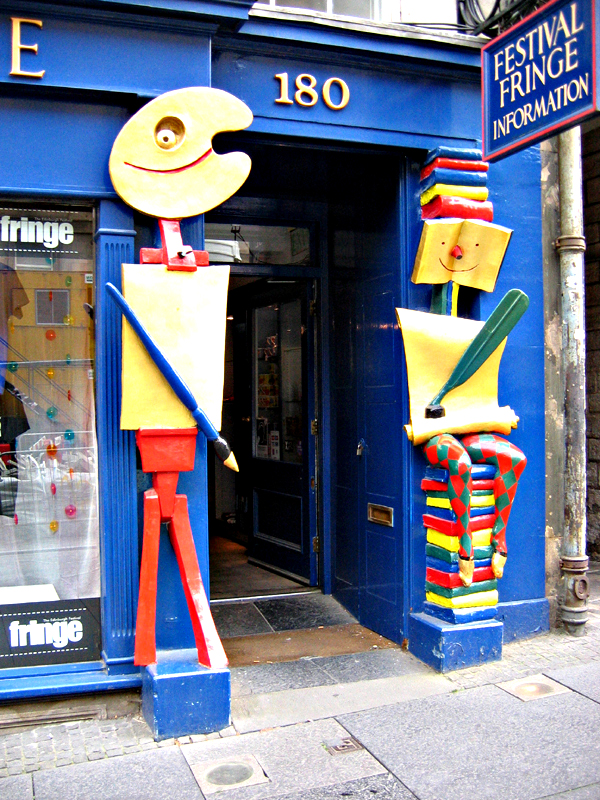
Edinburgh Festival Fringe Information 180 High Street © 2006 Scotiana
Hi everybody,
We don’t live in Edinburgh and, as the number of our visits there happen to be rather limited, our vision of this fascinating city owes much to our readings, each of them adding its little touch to the sense of place we got there and making us still more eager to go back to the beautiful Scottish capital.
From even before the times when it was nicknamed ‘Auld Reekie’, Edinburgh has been a great source of inspiration for poets and novelists. The Literary Traveller in Edinburgh by Allan Foster and The Edinburgh Literary Companion by Andrew Lownie are among my favourite books about this town and they can be very helpful to begin a literary tour of the first UNESCO City of Literature.
But is there a better way to discover the hidden face of Edinburgh than to follow on the steps of the many authors who have written about it and in so unforgettable pages, each one in his own manner? Today we’ll follow Alexander McCall Smith as he is one of the most popular contemporary Scottish writers. This writer was born in Zimbabwe but he has studied, taught and worked in Edinburgh where he is living now. His ’44 Scotland Street’ and ‘Sunday Philosophy Club’ series are set in Edinburgh. I’ve discovered this author recently and I like him very much. As I’ve already mentioned it, in one of my last posts about this author, the reading of Alexander McCall Smith’s books makes me relax, smile, laugh and think. Last but not least, there’s that ‘gentle touch’ in his books that makes you feel better 🙂
I’m now reading Espresso Tales, re-reading 44 Scotland Street (paying more attention to details) and, with Janice, we’re reading together The No.1 Ladies’ Detective Agency. We intend to read each of the many books of Alexander McCall Smith’s series and we’ve even begun to listen to Corduroy Mansions , the first episode of his ‘London series’ which is published on The Telegraph (not easy to reach the 1st episode… for there are many of them already!)
Scotland Street is an unassuming New Town street which does not quite possess the class of Heriot Row or Abercromby Place. Nevertheless, it is the setting for one of Edinburgh’s most famous fictional addresses: no. 44 Scotland Street (the street exists but no.44 does not). This celebrity status is due to Alexander McCall Smith’s daily novel of the same name which appeared in The Scotsman during 2004. (…) By the way, not only is no. 44 Scotland Street fictitious, but its residents are too, so if you’re after the blood of Bruce, the vain surveyor, you’ll have to vent your wrath on someone else.
(The Literary Traveller in Edinburgh – ‘New Town’ – Allan Foster – 2005)
I like the design of the book cover of Allan Foster’s The Literary Traveller, with its literary mosaic focusing on some of the most popular writers who are linked, one way or other, with Edinburgh. You can recognize, beginning from the upper left side of the cover and between several images of bookshops and one of the emblematic Literary Museum’s sign: Alexander McCall Smith, JK Rowling, Clarindas’ Tea room linked with Robert Burns, Sherlock Holmes’s statue, Ian Rankin, Irvine Welsh, Stevenson and Walter Scott. All these authors are of course on our reading lists, especially Sir Walter Scott, Louis Stevenson, Ian Rankin and Conan Doyle 😉
Leading north off Drummond Place is Scotland Street, described by Alexander McCall Smith in his novel 44 Scotland Street (2005) as lying ‘on the edge of the Bohemian part of the Edinburgh New Town, the part where lawyers and accountants were outnumbered – just – by others’.
Inspired by Armistead Maupin’s Tales of the City and originally a serial novel in The Scotsman, 44 Scotland Street centres on the lives of a range of characters living at this fictional address. There are numerous episodes set around the New town, most particularly in the Cumberland Bar in nearby Cumberland Street, and in various Edinburgh institutions such as Valvona & Crolla (an Italian delicatessen at the top of Leith Walk), Jenners tea-room, Sandy Bell’s bar and the Braid Hills Hotel – a favourite of Miss Jean Brodie – with walk on-parts given to a number of well-known Edinburgh residents such as Ian Rankin. (…)
(The Edinburgh Literary Companion Andrew Lownie Polygon 2005)
It is interesting to note that Alexander McCall Smith had just published 44 Scotland Street (2005) when the Literary Traveller in Edinburgh and The Edinburgh Literary Companion were published in 2005.
He didn’t appear in the edition of Andrew Lownie’s The Edinburgh Literary Guide, very beautifully illustrated by Richard Demarco, published in 1992. Alexander McCall Smith became popular with his detective novel The No. 1 Ladies’ Detective Agency which was the first volume of Mma Ramotswe series which takes place in Botswana.
I’m reading the paperback edition of 44 Scotland Street but I wanted to have a first edition of the book, with its beautiful cover, so it’s with great pleasure that I received it a few days ago. I was very happy to discover the illustrations all along the book and still more when I discovered that there was two maps of Edinburgh inside the covers of Alexander Smith’s novel.
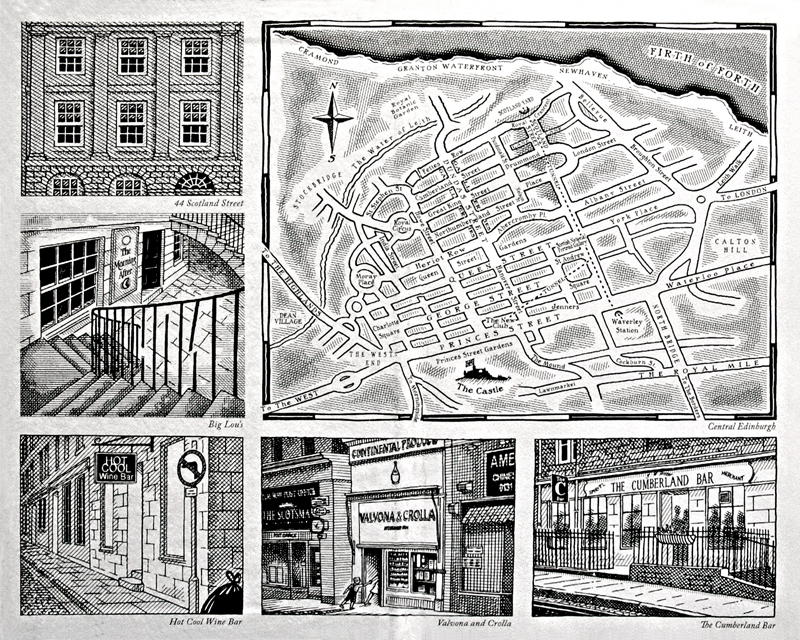
Alexander McCall Smith 44 Scotland Street 2005 Hardcover Polygon Edition Illustrations © Iain McIntosh 2005
Here they are! What a pity they don’t appear in the more recent editions of the book. They’re quite helpful, especially when you don’t know very well the city which takes so big a part in Alexander McCall Smith’s book.
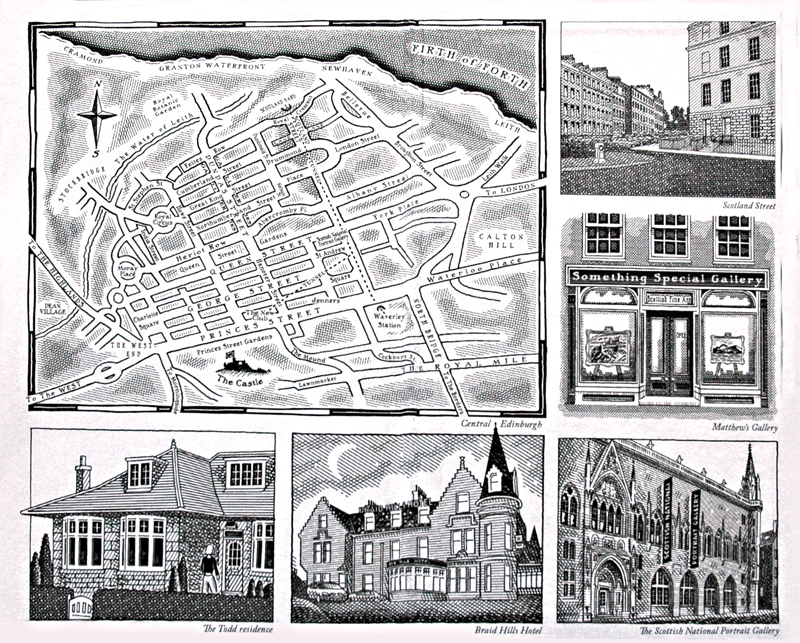
Alexander McCall Smith 44 Scotland Street 2005 Hardcover Polygon Edition Illustrations © Iain McIntosh 2005
This hardcover edition also contains a number of nice illustrations in it. Some of them are reproduced on the map pages, as you can see. I would just add another one which I like particularly. Here it is:
Cyril, the dog with the golden teeth! He’s one of my favourite characters with his master Angus and Domenica 😉
I’ve just mentioned the ‘gentle touch’. The passages about Cyril the dog and the relationship between master and dog have it. These are marvellous pages, full of humour and tenderness. To describe them as he does, Alexander McCall Smith surely does love animals (see also the description of the white cows of Mma Ramotswe’s father, in ‘The No.1 Ladies’ Detective’ series).
Now, I would end this post on a passage which moved me to the heart when I read it. It is situated at the beginning of chapter 86 entitled ‘On the Subject of Dogs’. It reads:
“On the subject of dogs,” said Angus Lordie, taking a sip of his whisky, “I’ve just discovered the most marvellous book. I came across it quite by chance – The Difficulty of Being a Dog. It’s by a French writer, Roger Grenier, who was a publisher apparently. He knew everybody – Camus, Sartre,Yourcenar – all of them, and he had a wonderful dog called Ulysse. The French title was Les larmes d’Ulysse, The Tears of Ulysses, which was rather better, in my view, than the one they used in English. But there we are. You don’t know it, by any chance?’
Oh YES I do know this marvellous little book and the very name of it rings a very touching bell, I can tell you. I happen to fall on Les larmes d’Ulysse, in 2000, in particularly sad times, just a few days after losing our dear dog. In Le rosier de Ralph, my ‘In Memoriam’ little book devoted to our friend, I wrote the incredible story which happened to me that day when I got out from a big supermarket with only that book in my hands to read it on a bench… I could not read my book then but, when I got out of the supermarket with Les larmes d’Ulysse and a feeling of gratitude to the gypsy boys I had just met, I didn’t wept any more but I smiled…
Many dogs are named Ulysses. But Ulysses’s own dog was named Argos. He waited for his master in less comfortable surroundings than Penelope’s. When the ever prudent King of Ithaca finally set foot on his island, he disguised himself with Athena’s help. And still Argos recognized him.
‘Now with his master gone he lay there, castaway, on piles of dung from mules and cattle, heaps collecting out before the gates till Ulysses’ serving-men could cart it off to manure the king’s estates. Infested with ticks, half-dead from neglect, here lay the hound, old Argos. But the moment he sensed Ulysses standing by, he thumped his tail, nuzzling low, and his ears dropped, though he had no strength to drag himself an inch toward his master. Ulysses glanced to the side and flicked away a tear…’
During Ulysses’ long exile, Poseidon had persecuted the Greek hero with the vindictive spirit for which the gods are known. Poseidon made Ulysses weep. But now that the traveler was home, it was his old dog who had the power to make him shed a tear.
(The Difficulty of Being a Dog – Roger Grenier – The University of Chicago Press 2002)
How I fell on Les larmes d’Ulysse, I still wonder…
But we don’t find books, they find us, don’t they?
Bonne lecture!
A bientôt. Mairiuna

Ralph on 'Le chemin de Ralph' près de L'Eau Bourde à Cestas - Août 1998 © 1998 Scotiana


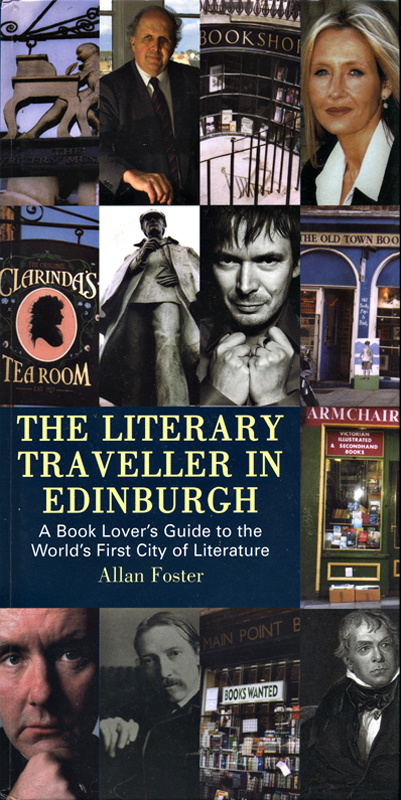






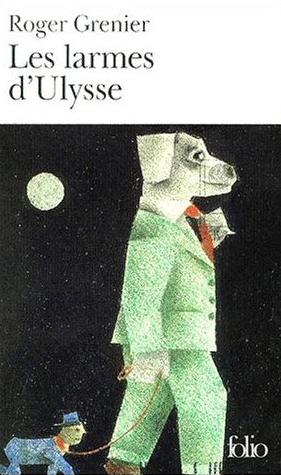
Leave a Reply